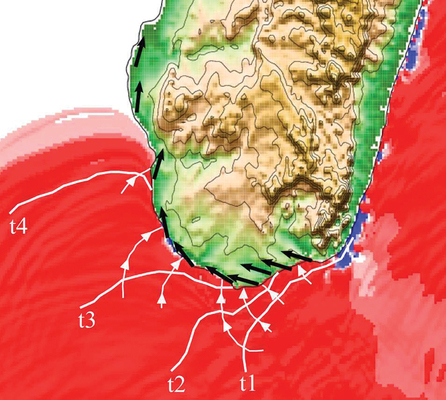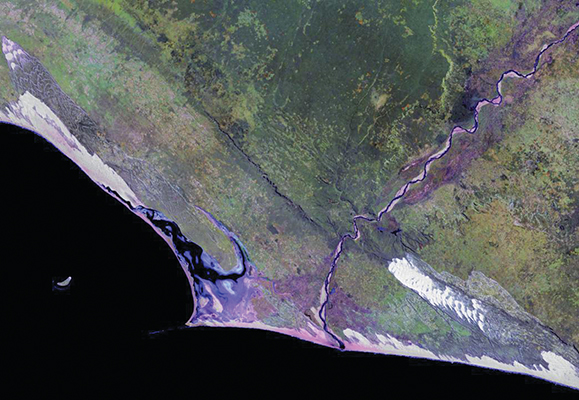
by Carolyn Gramling Thursday, January 5, 2012

Some models suggest the chevrons' orientations (black arrows) don't match the direction of arriving tsunami waves (white arrows). Robert Weiss

Tsunamis generated by asteroid impacts may have left white, sandy "chevron" deposits in Madagascar. Robert Weiss
About four years ago, a group of scientists proposed that a series of giant, wedge-shaped sandy deposits found along the shores of southern Madagascar might be evidence of a giant tsunami — a “mega-tsunami” — generated by an asteroid that may have blasted into the Indian Ocean sometime in the last 10,000 years. Furthermore, the scientists said, such impacts and the resulting tsunamis may have occurred fairly frequently during this period. To search for evidence of these impacts, the researchers formed the Holocene Impact Working Group. By 2006, with the help of Google Earth, they found dozens more of the wedge-shaped deposits, called chevrons, scattered across the planet, including in Africa, Australia and the United States.
But whether these chevrons are actually evidence of giant tsunamis has been a matter of debate, says Joanne Bourgeois, a sedimentary geologist at the University of Washington in Seattle. Now, she and geologist Robert Weiss of Texas A&M University in College Station assert that winds, not mega-tsunamis, formed the chevrons.
In 2006, a New York Times article on the growing number of chevrons identified with mega-tsunamis brought the matter to Bourgeois' attention, she says. “I remember going to the Web site and looking at the [Madagascar] chevrons. They were really impressive; you can see them from satellites.” But Bourgeois, who has worked on regular tsunami deposits, says that the deposits looked wind-driven, not giant-wave-driven. “There were a lot of things that didn’t seem to click. Some were active, and you could tell they were of different generations. They looked like they were windblown dunes.”
One major question was the angle of the deposits relative to the shoreline, Bourgeois says. As a tsunami approaches the shore, the wave becomes more or less parallel to the shoreline and it will wash straight in, she says. But the Madagascar dunes formed at a high angle to the shore. “That’s common for wind, which isn’t steered by the local topography,” she says. A 2008 article countering the mega-tsunami hypothesis, by geologists Nicholas Pinter and Scott Ishman of Southern Illinois University in Carbondale, also pointed out that the deposits appeared to be parallel to the direction of the prevailing winds.
Bourgeois and Weiss decided to take a closer look at whether it would be possible for a mega-tsunami to have deposited the chevrons. Focusing on two cases — the Madagascar chevrons and a series of chevrons found in Australia — they modeled how mega-tsunamis would behave as they approach the coast and how they might transport sediment. In their models, the waves generated by a theoretical asteroid impact in the ocean spread out in a circular pattern until they reached shallower waters, where they refracted against the seafloor. The waves, bearing the sediment load that would ultimately form the chevrons, then became parallel to the shoreline — an orientation inconsistent with the chevrons’ actual orientation, the researchers reported in Geology.
The models of sediment transport also suggested another strike against the mega-tsunami hypothesis: The chevrons are made up of ripples and dunes, Bourgeois says — evidence of a certain kind of sediment transport called “bed load,” in which the grains bounce along the sediment bed until they finally come to rest. Less powerful water flows or winds would carry sediments as bed load, but a giant, powerful wave would be able to fully suspend sediment grains of many sizes, carrying them far across the shoreline until they are finally deposited — forming a sheet of sand, rather than dunes.
But Dallas Abbott, a geologist at Columbia University’s Lamont-Doherty Earth Observatory in Palisades, N.Y., and a member of the Holocene Impact Working Group, remains unconvinced that the chevrons are not tsunami deposits. She takes issue with several points in the paper: For one thing, Abbott says, there are marine microfossils present in the chevrons that are too large to have been transported by the wind. And tsunamis generated by impacts behave differently than tsunamis generated by earthquakes, she adds, so that the waves would arrive at the shore from a different angle. “The biggest problem with modeling is that if you start out with the wrong assumptions, you get the wrong answer,” she says.
Peter Bobrowsky, a geologist at Natural Resources Canada in Ottawa who is not affiliated with either group, says he finds Bourgeois and Weiss' quantitative approach to the problem to be convincing. Through their modeling of the tsunami fluid dynamics and sediment transport, he says, Bourgeois and Weiss “did a very good job of discrediting [the mega-tsunami] hypothesis.”
The mega-tsunami hypothesis poses “an interesting, enticing problem,” Bobrowsky adds, but without convincing evidence either way, the burden of proof is still on the idea’s proponents. Many of the challengers of the hypothesis, he adds, have quoted Carl Sagan’s statement that “extraordinary claims need extraordinary evidence.” To really move the tsunami hypothesis forward, he says, researchers will need to locate offshore evidence of an impact — something for which the Holocene Impact Working Group continues to search.
© 2008-2021. All rights reserved. Any copying, redistribution or retransmission of any of the contents of this service without the expressed written permission of the American Geosciences Institute is expressly prohibited. Click here for all copyright requests.